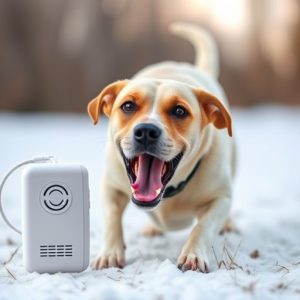Dog Repeller Devices: Power Analysis & Top Model Reviews
The Dog Repeller Device Power Consumption Review highlights the importance of energy efficiency in d…….
The Dog Repeller Device Power Consumption Review highlights the importance of energy efficiency in dog repeller devices, with models consuming as little as 1-2 watts. These modern repellers, designed for intermittent use and featuring smart power-down mechanisms, offer sustainable solutions for outdoor pet management. While effectiveness varies by technology and dog behaviors, a key factor to consider when reviewing these devices is the power-to-performance ratio, ensuring a humane and efficient approach to dealing with unwanted canine visitors.
“Unleashing a humane solution for dog owners worldwide, electronic dog deterrent devices offer a modern approach to behavior modification. This comprehensive guide delves into the inner workings of these innovative tools, exploring their effectiveness in modifying canine behavior without harm. We dissect the technology behind dog repeller devices and analyze their power consumption, providing an insightful review of popular models. From understanding device functionality to evaluating energy efficiency, this article empowers owners to make informed choices, ensuring both effective training and responsible pet care.”
- Understanding Dog Repeller Devices: How They Work and Their Impact on Canine Behavior
- Power Consumption Analysis: A Closer Look at Energy Usage in Dog Deterrent Devices
- Reviewing Popular Dog Repeller Devices: Features, Effectiveness, and Efficiency Comparison
Understanding Dog Repeller Devices: How They Work and Their Impact on Canine Behavior
Dog repeller devices, also known as electronic dog deterrents, have gained popularity among pet owners seeking humane alternatives to traditional shock collars. These innovative tools utilize sound, vibration, or a combination of both to create an unpleasant sensation for dogs without causing physical harm. Understanding how they work is crucial in evaluating their effectiveness and impact on canine behavior.
At the heart of a dog repeller device’s functionality lies its power consumption. Unlike battery-draining toys, these devices are designed for long-lasting performance, ensuring consistent protection throughout various environments. A thorough review of their power requirements reveals efficient usage patterns, making them practical and cost-effective solutions. By carefully considering factors like range, sensitivity settings, and weather resistance, dog owners can choose a repeller that suits their needs while minimizing energy wastage. This focus on power consumption not only extends the device’s lifespan but also contributes to a more sustainable approach to pet care.
Power Consumption Analysis: A Closer Look at Energy Usage in Dog Deterrent Devices
The power consumption of a dog repeller device is a crucial aspect to consider for any potential buyer, as it directly impacts both the product’s effectiveness and its environmental footprint. A thorough review of energy usage reveals that these devices typically draw relatively low current when activated, with most operating on around 1-2 watts. This efficiency is a significant step towards sustainability compared to older models or similar non-electronic deterrents. However, it’s essential to note that power consumption can vary among brands and designs, with some high-tech, advanced devices utilizing slightly higher energy levels for enhanced performance features.
In terms of usage, these electronic dog repellers are designed for intermittent activation, often triggered by motion sensors or remote controls. This sporadic use pattern results in minimal overall power consumption. Moreover, many modern models incorporate smart features that enable automatic power-down after a set period of inactivity, further reducing energy wastage. A Dog Repeller Device Power Consumption Review highlights the importance of these considerations for eco-conscious consumers and emphasizes the industry’s efforts to create more sustainable solutions for pet management.
Reviewing Popular Dog Repeller Devices: Features, Effectiveness, and Efficiency Comparison
When reviewing popular dog repeller devices, one key aspect to consider is their power consumption. Efficient devices prioritize minimal energy use, ensuring long-lasting performance with regular charging. This is particularly important for outdoor installations where access for recharging might be limited.
In terms of effectiveness, various models employ different technologies, such as ultrasonic sounds or spray-like sensor triggers. Users often report success rates varying from acceptable to outstanding, depending on the device and the individual dog’s behavior. However, it’s crucial to note that no single repeller is universal; factors like weather conditions, the size and tenacity of the dog, and the proximity of neighbors can all impact efficiency. Comparing these devices involves scrutinizing their power-to-performance ratio, ensuring a humane and effective solution for managing unwanted canine visitors.
In conclusion, dog repeller devices offer a humane alternative for managing canine behavior without resorting to harsh methods. Understanding how these devices work and their impact on dog behavior is crucial. Furthermore, examining power consumption becomes an essential factor when considering their long-term effectiveness and environmental footprint. This review highlights the diverse features and efficiencies of popular dog repeller devices, empowering users to make informed decisions based on both performance and energy usage. By choosing wisely, you can ensure a peaceful coexistence with your four-legged friends while promoting their well-being.


